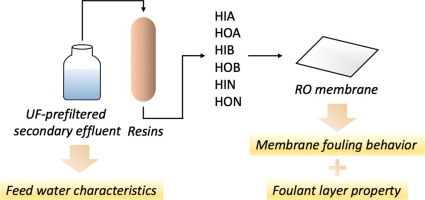Separation and Purification Technology ( IF 8.1 ) Pub Date : 2018-09-21 , DOI: 10.1016/j.seppur.2018.09.062 Shu Wang , Kang Xiao , Xia Huang

|
In this study, various fouling characteristics on the surface of a commercial reverse osmosis (RO) membrane were identified, in terms of different organic and inorganic components. Specifically, a practical secondary wastewater of coal chemical industry was used as the feed solution, and was fractionated into six hydrophobic/hydrophilic acid/base/neutral portions. RO membrane fouling behaviors at different stages were critically described using two characteristic parameters, i.e., initial flux decline rate and final steady-state flux. These parameters were quantified using Michaelis-Menten relation as a model fitting method. In general, the hydrophilic neutral (HIN) and hydrophobic neutral (HON) fractions had the fastest initial fouling rate and the lowest steady-state flux, mainly due to their high contents of polysaccharide. Among the organic constituents (polysaccharide/protein/humic acid), polysaccharide was the most responsible for rapid initial flux decline and low final steady-state flux, as proved by Kendall’s correlation. Among the inorganic constituents (Ca/Mg/Si), Si was found to exert the greatest influence on the final steady-state flux. This indicates that polysaccharide and Si played a combined role in determining the foulant layer permeability at the prolonged fouling stage, and a possible mechanism is that Si might alter the structure of polysaccharide gel layer. Further information on the fouling layers was systematically provided by means of Fourier transform infrared spectroscopy, confocal laser scanning microscopy, X-ray photoelectron spectroscopy, and scanning electron microscopy with fractal dimension analysis.
中文翻译:

表征有机和无机污垢在反渗透膜结垢发展中的作用:以煤化工废水处理为例
在这项研究中,根据不同的有机和无机成分,确定了商业反渗透(RO)膜表面的各种污垢特征。具体地,将煤化学工业的实际二级废水用作进料溶液,并将其分馏成六个疏水/亲水酸/碱/中性部分。使用两个特征参数,即初始通量下降率和最终稳态通量,严格描述了反渗透膜在不同阶段的结垢行为。这些参数使用Michaelis-Menten关系作为模型拟合方法进行了量化。通常,亲水性中性(HIN)和疏水性中性(HON)馏分具有最快的初始结垢速率和最低的稳态通量,这主要是由于它们的多糖含量高。肯德尔相关性证明,在有机成分(多糖/蛋白质/腐殖酸)中,多糖是导致初始通量快速下降和最终稳态通量低的主要原因。在无机成分(Ca / Mg / Si)中,发现Si对最终稳态通量的影响最大。这表明在延长的结垢阶段,多糖和Si在决定结垢层渗透性方面起着共同的作用,可能的机理是Si可能会改变多糖凝胶层的结构。通过傅立叶变换红外光谱,共聚焦激光扫描显微镜,X射线光电子能谱和具有分形维数分析的扫描电子显微镜系统地提供了有关结垢层的更多信息。











































 京公网安备 11010802027423号
京公网安备 11010802027423号